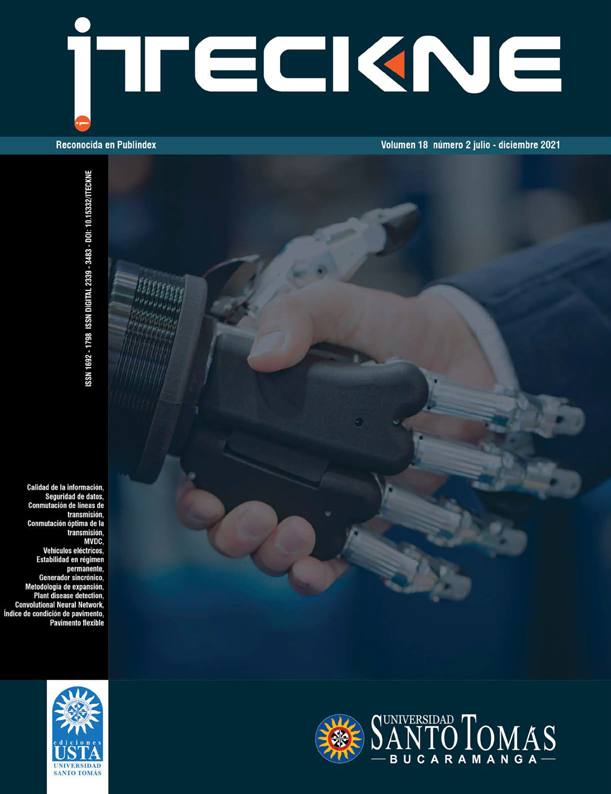An approach to Plant Disease Detection using Deep Learning Techniques
Abstract
Agriculture is the backbone of Indian economy. Conventional farming systems are no longer being followed by our generation, due to lack of knowledge and expertise. Advancement of technologies pave a path that make a transition from traditional farming methods to smart agriculture by automating the processes involved. Challenges faced by today’s agriculture are depletion of soil nutrients and diseases caused by pests which lead to low productivity, irrigation problems, soil erosion, shortage of storage facilities, availability of quality seeds, lack of transportation, poor marketing etc. Among all these challenges in agriculture, prediction of diseases remains a major issue to be addressed. Identifying diseases based on visual inspection is the traditional way of farming which needs knowledge and experience to handle. Automating the process of detecting and identifying through visual inspection (cognitive) is the motivation behind this work. This is made possible with the availability of images of the plant or parts of plants, since most diseases are reflected on the leaves. A deep learning network architecture named Plant Disease Detection Network PDDNet-cv and a transfer learning approach of identifying diseases in plants were proposed. Our proposed system is compared with VGG19, ResNet50, InceptionResNetV2, the state-of-the-art methods reported in [9, 13, 5] and the results show that our method is significantly performing better than the existing systems. Our proposed PDDNet-cv has achieved average classification accuracy of 99.09% in detecting different classes of diseases. The proposed not so deep architecture is performing well compared to other deep learning architectures in terms of performance and computational time.
Downloads
References
[2] Kamilaris, A., Prenafeta-Boldú, F., “A review of the use of convolutional neural networks in agriculture” The Journal of Agricultural Science, 156(3), 312–322 (2018). DOI: https://doi.org/10.1017/S0021859618000436
[3] Sankaran, S., Mishra, A., Ehsani, R., Davis, C., “A review of advanced techniques for detecting plant diseases”, Computers and Electronics in Agriculture, 72(1), 1–13 (2010). DOI: https://doi.org/10.1016/j.compag.2010.02.007
[4] Sharif, M., Khan, M.A., Iqbal, Z., Azam, M.F., Lali, M.I.U., Javed, M.Y., “Detection and classification of citrus diseases in agriculture based on optimized weighted segmentation and feature selection”, Computers and electronics in agriculture, 150, 220–234 (2018). DOI: https://doi.org/10.1016/j.compag.2018.04.023
[5] Wang, G., Sun, Y., Wang, J., “Automatic image-based plant disease severity estimation using deep learning”, Computational intelligence and neuroscience, 2017 (2017). DOI: https://doi.org/10.1155/2017/2917536
[6] Sladojevic, S., Arsenovic, M., Anderla, A., Culibrk, D., Stefanovic, D., “Deep-neural-networks-based recognition of plant diseases by leaf image classification”, Computational intelligence and neuroscience, 2016 (2016). DOI: https://doi.org/10.1155/2016/3289801
[7] Shin, H.C., Roth, H.R., Gao, M., Lu, L., Xu, Z., Nogues, I., Yao, J., Mollura, D., Summers, R.M., “Deep convolutional neural networks for computer-Aided detection, CNN architectures, dataset characteristics and transfer learning”, IEEE transactions on medical imaging, 35(5), 1285–1298 (2016). DOI: https://doi.org/10.1109/TMI.2016.2528162
[8] Mohanty, S.P., Hughes, D.P., Salath´e, M., “Using deep learning for image-based plant disease detection”, Frontiers in plant science, 7, 1419 (2016). DOI: https://doi.org/10.3389/fpls.2016.01419
[9] Fuentes, A., Yoon, S., Kim, S., Park, D.,” A robust deep-learning-based detector for real-time tomato plant diseases and pest recognition”, Sensors,17(9), 2022 (2017). DOI: https://doi.org/10.3390/s17092022
[10] Ferentinos, K.P., “Deep learning models for plant disease detection and diagnosis”, Computers and Electronics in Agriculture, 145, 311–318 (2018). DOI: https://doi.org/10.1016/j.compag.2018.01.009
[11] Tan, C., Sun, F., Kong, T., Zhang, W., Yang, C., Liu, C., “A survey on deep transfer learning”, In, International Conference on Artificial Neural Networks, pp. 270–279. Springer (2018). DOI: https://doi.org/10.1007/978-3-030-01424-7_27
[12] Kaya, A., Keceli, A.S., Catal, C., Yalic, H.Y., Temucin, H., Tekinerdogan, B., “Analysis of transfer learning for deep-neural-network-based plant classification models”, Computers and Electronics in Agriculture, 158, 20–29 (2019). DOI: https://doi.org/10.1016/j.compag.2019.01.041
[13] Simonyan, K., Zisserman, A., “Very deep convolutional networks for large-scale image recognition”, arXiv preprint arXiv, 1409.1556 (2014).
[14] He, K., Zhang, X., Ren, S., Sun, J., “Deep residual learning for image recognition”, In, Proceedings of the IEEE conference on computer vision and pattern recognition, pp. 770–778 (2016).
[15] Szegedy, C., Liu, W., Jia, Y., Sermanet, P., Reed, S., Anguelov, D., Erhan, D., Vanhoucke, V., Rabinovich, A., “Going deeper with convolutions”, In, Proceedings of the IEEE conference on computer vision and pattern recognition, pp. 1–9 (2015).
[16] Szegedy, C., Ioffe, S., Vanhoucke, V., Alemi, A.A., “Inception-v4, Inception-ResNet and the Impact of Residual Connections on Learning”, In, Thirty-First AAAI Conference on Artificial Intelligence, pp. 1–12 (2017).
[17] Denton, E.L., Zaremba, W., Bruna, J., LeCun, Y., Fergus, R., “Exploiting linear structure within convolutional networks for efficient evaluation” In, Advances in neural information processing systems, pp. 1269–1277 (2014).
[18] Ramcharan, A., Baranowski, K., McCloskey, P., Ahmed, B., Legg, J., Hughes, D.P., “Deep learning for image-based cassava disease detection”, Frontiers in plant science, 8, 1852 (2017). DOI: https://doi.org/10.3389/fpls.2017.01852
[19] Barbedo, J.G.A., “Plant disease identification from individual lesions and spots using deep learning”, Biosystems Engineering, 180, 96–107 (2019). Doi: https://doi.org/10.1016/j.biosystemseng.2019.02.002
[20] Barbedo, J.G.A., “Impact of dataset size and variety on the effectiveness of deep learning and transfer learning for plant disease classification”, Computers and Electronics in Agriculture, 153, 46–53 (2018). DOI: https://doi.org/10.1016/j.compag.2018.08.013
[21] Hughes, D., Salath´e, M., et al., “An open access repository of images on plant health to enable the development of mobile disease diagnostics”, arXiv preprint arXiv, 1511.08060 (2015).
[22] Santosh Adhikari Bikesh Shrestha, B.B., K.C., S.K., “Tomato plant diseases detection system using image processing”, In, Proceedings of KEC Conference, 2018, pp. 1–6 (2018).



















